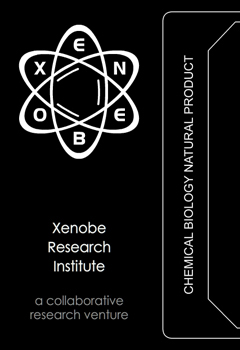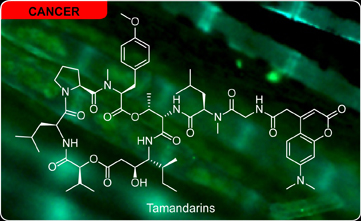

Tamandarin Depsipeptides

The didemnin family of depsipeptides was originally isolated in 1981 from the Caribbean tunicate Trididemnum solidum by Reinhart (read it now). Early investigation into the bioactivity of this compound and structurally related Tamanadarins A/B revealed marked antiviral and cytotoxic activity (read it now). To date, Didemnin B has been shown to interrupt protein synthesis by binding to palmitoyl protein thioesterase (read it now)and bind to GTP dependent elongation factor EF-1 alpha (read it now). While these target has been validated, both pathways fail to provide complete explanation of its antiproliferative activity (examine a review).
In studies beginning in the late 1990’s, we have conducted extensive experimentation on this material in collaboration the Joullie laboratory. After examination in fish, worm, and tumor cell models, we have now identified a complete composite of the anatomical, cellular and molecular targets of the didemnin and tamanadrin depsipeptides. The lead in these studies was identified using a unique fish model, Kryptopterus bicirrhus, whose transparency allowed us to complete a full in vivo analysis of the uptake and localization of fluorescent analogs of tamandarin and didemnin core (read it now). Interestingly, a unique pattern developed that was not only well suited to the ecological role of these materials. As shown in the figure above, fluorescent analogs of didemnin B and tamandarin A localized within chondrocyte cells in the spine and fins (dorsal fin shown). The blue fluorescence shown in the figure above arises from a IAF-labeled analog of tamandarin A.
Using an optimized method for small molecule co-immunoprecipitation, we determined that fluorescent analogs of tamandarin A and didemnin B selectively pull down a family of Icam molecules in human cells and zebrafish. Interestingly, these targets are commonly expressed within the chondrocyte cells of K. bicirrhus and zebrafish. Studies are now underway to validate these targets. There was an excellent review on this work and the family of natural products in general recently published by the Joullie laboratory (read it here).
Recently, there were a series of manuscripts describing the biosynthetic source of the didemnins (read it here or here). These studies, not only provide a vital example of marine microbial symbiosis, but also open new avenues for the clinical translation of this family of natural products.
Copyright 2004-2012 | The Xenobe Research Institute | a California-based 501(c)(3) organization.